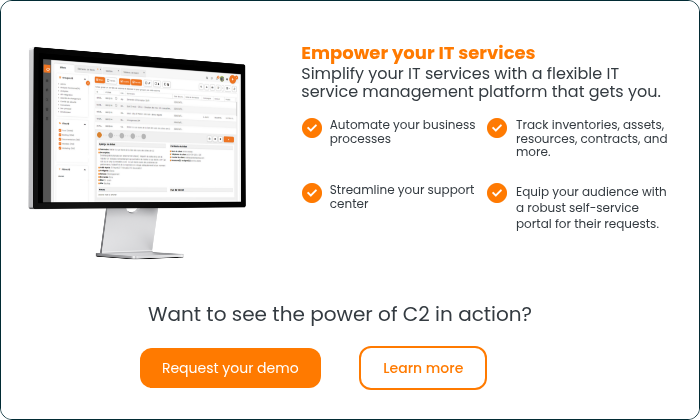ITSM practices center on the use of a service desk. The service desk is a single point of contact for users to request anything they need from an IT organization. That could be an essential support question or something more complex, such as a request for new app development or a new employee onboarding sequence.
ITSM practices can provide a solid structure for your business. Successfully adopting those practices requires some tools, namely ITSM service desk software. If you’re looking for an ITSM service provider, you should ask every provider you contact three key questions.
The right ITSM service provider can help organizations streamline practically everything
Good ITSM software from a reliable provider offers many benefits, including service management, problem management, change management and process automation.
Service management
ITSM software allows you to structure your managed IT resources into a service catalogue matched to your organizational structure. For example, you can pair different service requests to company departments. Having this structure available makes individual service requests and large-scale projects easier to manage and more straightforward for IT staff to understand.
Problem management
Problem management becomes much easier with ITSM software because services, work histories and knowledge bases are well-structured within the system. You can respond to incidents much faster. Post-incident investigations and changes are also easier when you can track service dependencies and understand incidents in context, like service management.
CMDB and change management
The right ITSM software also allows you to see the relationships between every application, server and network resource through a CMDB. It makes it much easier to avoid service disruptions created by an incomplete understanding of what infrastructure will be affected by planned changes. You can also optimize your license usage with visibility over when a certain change makes a given server or license redundant.
Process automation
Automating manual processes is a great way to improve efficiency, maintain consistent workflows, and delegate tasks. You can configure actions and approval requests to trigger in ITSM software without any human intervention, saving your business time and money.
Before you buy, ask ITSM service providers some questions
ITSM practices and ITSM service desk software can deliver significant value to organizations that adopt them. That’s why ITSM has become part of many internationally recognized standards.
However, using service desk software that’s a poor fit for your organization will be no better than having no ITSM practices. You’ll go through the motions of IT service management without gaining any benefits. Moreover, assessing and tracking your organization’s performance and support processes will be increasingly difficult. With that said, make sure your ITSM service provider can do the following:
Quantify performance
When correctly customized to track how your business and your customers work, ITSM software can help you evaluate how effectively you use your IT resources.
Track asset histories
Automated ITSM software can track which assets are tied to which incident reports. You can dig back through detailed logs and identify problem patterns. That information can help inform future upgrades, purchasing decisions, or even acceptable use policy updates for you or your customers.
Effectively structure support processes
The whole purpose of implementing ITSM is to employ predictable, standardized processes to manage your service requests. If a service desk app isn’t a good fit for your organization, inconsistency will creep around the edges, eroding the efficiencies you hoped to gain.
You can avoid these potential headaches if you ask the ITSM service providers; you’re considering these three questions:
#1 What’s your onboarding process like?
You can judge a great deal about an ITSM service provider based on their onboarding process. Change management is a core concept of ITSM, so you should assess how well their platform will work for your organization based on how well they can introduce and customize it for your organization.
Does the provider offer API integrations and webhook triggers? Can you use your Active Directory structure or start from scratch? Will you need in-house scripting expertise, or is it a codeless solution? What support and training resources do they offer? These are all additional onboarding questions you could ask.
#2 What licensing options do you offer?
You don’t want to sign up for a new ITSM cloud account only to discover that the supposed one-size-fits-all license doesn’t fit your needs. Before purchasing, ask an ITSM service provider about their different licensing options. Which base services are available to all accounts? Which is premium?
You’ll also want to investigate the structure of their licenses. For example, will you need to buy new licenses for each new named user, or is it licensed based on concurrent connections?
That licensing structure can significantly impact your monthly expenses based on how you staff your business. Concurrent licensing would be beneficial if you have different staff online at any given time. Perhaps you have a distributed workforce or many technicians moving between the office and on-site work on any given day.
#3 What sets you apart?
What is this ITSM service provider’s unique selling point or value proposition? Why should you choose them over the competition?
Get a clear idea of the vendor’s capabilities. Is their software just a ticketing system, or do they offer a complete ITSM toolset with features for change management, incident management and other best practices? Do they run their cloud app on reliable infrastructure?
Partner with a reliable ITSM service provider and take your org to the next level
High-quality ITSM software can give small and medium-sized organizations access to the same resources as their enterprise-scale competitors. Not only can it set you apart from local competition, but it can also truly level the playing field between your business and the major players in the market by improving focus and productivity.
That is, as long the software is the right fit for your organization. Ask any provider you’re considering the three questions above to determine whether they’re suitable for your specific organization!






